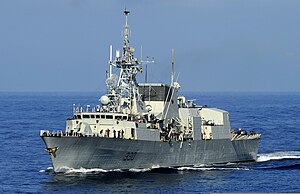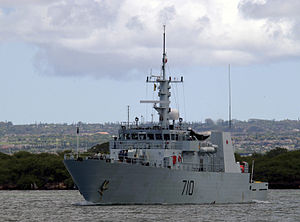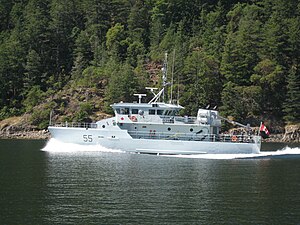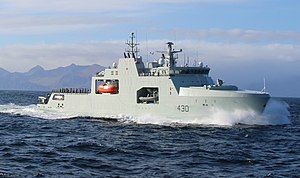Royal Canadian Navy
The Royal Canadian Navy is Canada's Navy. Founded in 1910, the United Kingdom's Royal Navy provided a few vessels, and some officers, to help guide the new service. Other vessels, like the lightly armed fishery patrol vessel CGS Petrel, were transferred from other departments.
The Royal Canadian Navy was small during the interwar years, but rapidly expanded during World War II, when Canada operated a large fraction of the escort vessels in the Battle of the Atlantic.
Commentators say that Canada had the world's third largest Navy at the end of World War II, but most of these were small escort vessels displacing less than 2,000 tonnes.
Following World War II the Navy maintained a Navy that remained focused around escort vessels. During the decades since then the Navy retired its few remaining non-escort vessels. Its overall size has declined.
The Canadian Navy did introduce an innovation now widely copied. In the 1960 it developed a technique for landing a helicopter on a small flight deck, even during bad weather, when the deck would be heaving up and down. The pilot would lower a special hook, and a crew member on the flight deck would lock it into a device called a "bear trap", in the middle of the flight deck. The pilot would put the rotors on maximum intensity, and count on the cable to tow the copter safely to the center of the flight deck. With the hook still holding the copter firmly, it could be towed into its hangar, after its rotors were folded.
Halifax class
The Navy operates 12 Halifax class frigates, which were seen as competitive with the frigates from other navies, when they were built approximately 30 years ago.
These vessels each carry one large helicopter in an enclosed hangar.
Kingston class
It also operates 12 Kingston class minesweepers. These vessels were built using commercial off the shelf components, to save funds. They aren't particularly fast, and, as built, they were very lightly armed. Their main armament was a World War II vintage 40 mm bofors cannon. Some of the cannons were stripped from museums. The 40 mm cannon were retired leaving the vessels armed only with a pair of Browning machine guns.
Orca class
It operates 8 Orca class patrol vessels, in the 200 ton range. These lightly armed vessels are used for training.
The Navy purchased four former Royal Navy submarines, which have been plagued with problems, and have seen very little time at sea.
Harry DeWolf offshore patrol vessels
The Navy's most recent purchases were a class of icebreakers, which are also supposed to serve as offshore patrol vessels.
Originally a smaller number of more powerful icebreakers was going to be built. When the government decided to built a larger number of less powerful icebreakers some critics called the "slushbreakers".
Because the veseels are designed to break ice they are slower and consume more fuel than other navy's offshore patrol vessels.
They are equipped with a large helicopter, like Canada's frigates. The main armament of these vessels is just a 25mm autocannon, the navalized version of the cannon mounted on a Bradley armored vehicle.



